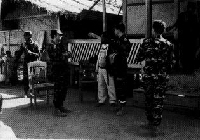| CHT |
| Background |
| Bangladeshi Settlers |
| Armed Resistance |
| Massacres |
| Genocide |
| Religious Persecution |
| Rapes & Abductions |
| Jumma Refugees |
| CHT Treaty |
| Foreign Aid |

Chittagong Hill Tracts is one of the most militarized zone in the world. There is a Bangladesh Military person for every 6 Jumma civilians.
One of the most salient features of the Chittagong Hill Tracts (CHT) is the all-pervading presence of military and para-military forces. The military is linked at the highest levels with the civil administration. The justification for the massive military build-up in the CHT was that it was needed to counter and contain insurgency activities of the Shanti Bahini (SB). Counter-insurgency was their main task. This included not only typical military operations, but also development programs. The 24th Infantry Division of the Bangladesh Army is in charge of the Chittagong Hill Tracts. The overall command for the CHT is with the General Officer Commanding (GOC) in the Chittagong Cantonment in Chittagong town.
The army has four Brigade Headquarters in the CHT: Rangamati, Khagrachari and Dighinala in the north, and Bandarban in the south. There are garrisons in Ruma and Alikadam in the south and there are army base camps in each Upazilla Headquarters in the CHT as well as in various villages. In some villages there are camps that are not called base camps but just 'camps'. There are also 'road protection camps' to prevent Shanti Bahini attacks in the daytime. At night the soldiers withdraw to the base camps. There are road protection camps on almost every hill top along the main roads in the northern CHT. From 4 p.m. until about 9.30 a.m. all main roads are closed. The army searches all roads for explosives before opening them in the morning.
At Kaptai there is also a naval base. Helicopters are frequently used to transport people and goods, to patrol and to fight the Shanti Bahini.
The Bangladesh Rifles (BDR) is a para-military force whose task is to control the border and check illegal crossings. However BDR camps are found deep inside the CHT. The BDR are also involved in counter-insurgency under the command of the GOC.
The Police in the CHT also have a counter-insurgency role under the command of the GOC. Police officers who are stationed in police camps are more heavily armed than those in police stations, who are involved primarily in criminal investigation.
Another paramilitary force is the Ansar (Islamic Guards) which operates throughout Bangladesh. Although the Ansar have their own command structure, their counter insurgency role in the CHT is monitored by the GOC.
Finally there are the Village Defence Parties (VDPs), a voluntary paramilitary civil defence force. The VDPs are selected from among the Bangladeshi settlers.
The Ansar and the VDP carry out their counter-insurgency role under army control; their other activities come under the command of the police.
Military Strength
From military sources the CHT Commission gathered that there are over 230 army camps, more than 100 BDR camps and over 80 police camps in the CHT. In the north there are over 200 army camps, more than 90 BDR camps and over 40 police camps; in the south (Bandarban District) there are more than 30 army camps, over 40 police camps and nine BDR camps. These figures do not include Ansar or the Village Defence Parties.
The CHT Commission had an impression that the numbers of armed personnel provided by the Bangladesh military was very low, particularly in comparison with the estimates provided by informants from among the Jumma people. The estimates given to the Commission by sources from among the Jumma people, not taking into account VDPs and Police are:
| Army | 24th Infantry Division | 80,000 personnel |
| BDR | 6 Battalions | 25,000 |
| Ansars | 4 Battalions | 8,000 |
| Navy | 1 Battalion | 1,500 |
| Total | 114,500 |
Earlier reports on the CHT have estimated the military strength from 30,000 in 1981 (one third of all the regular troops in Bangladesh) to 120,000 in 1984 (including para-military and police forces). Military handbooks such as Military Balance (1989/90), Military Technology (1989) and Military Powers (1990) estimate the number of army personnel in Bangladesh as varying between 80,000 and 90,000 (excluding navy and air force) plus 55,000 to 80,000 para-military forces (including armed police). If these figures are accurate, the sum of 80,000 army personnel in the 24th Division seems too high. However, as the CHT is the only region in Bangladesh where there had been armed struggle, a large proportion of the armed forces is deployed there. The ratio of military personnel and the number of Jumma civilian in the CHT is 1:6 (one military person behind every 6 Jumma civilians), this makes the CHT most militarized region on earth. The number of troops in the CHT have not diminished even after the CHT Treaty signed in December 1997.
Sources:
- Life is not ours: the Chittagong Hill Tracts Commission